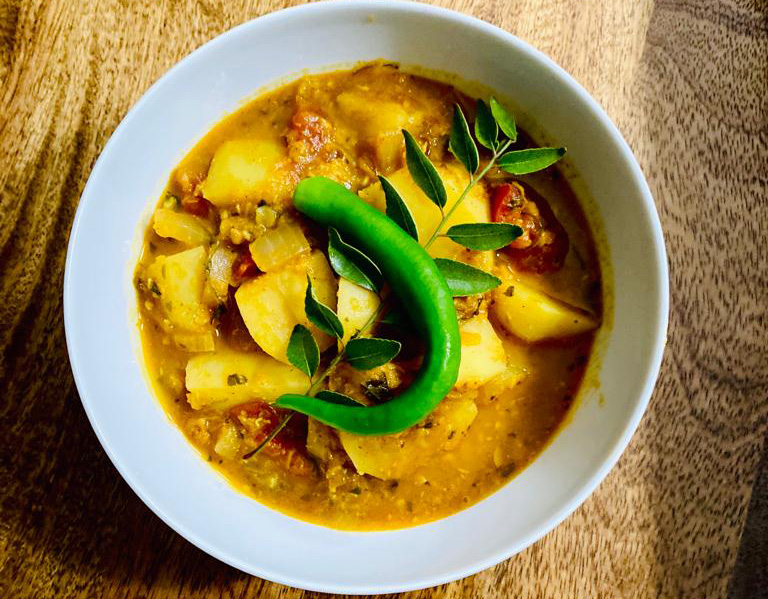South Indian Lentil Curry using Mysore Dhal
Dhal or lentil-curry can be prepared in about a 100 ways. There is no set standard of excellence attributed to the taste of dhal except that it should be heart-warming. And therefore I am going to tell you straight up, that this is probably not how your Indian friend or neighbour makes it. Everyone who goes down the Dhal-Road makes it in a way that warms their palate.
I am from South India and this is how my mother and grandmother made theirs. It has the taste of all the spices that engender memories of my home state of Kerala. In Kerala we call this parippu curry.
After spending years on this beautiful island, making many pots of red lentils or Dhal for friends, this is the method I’ve settled on, tweaking my mother’s recipe a tiny bit, for its balance of taste and simplicity and for the ingredients that are available in the local market. As a rule, I use therapeutic spices for their inherent value and taste. Plus my kids love it, and it is so easy to make.
1 cup Mysore Dhal – (orange or red lentils, washed and drained well)
3/4 cup chopped onions
1⁄2 tsp mustard seeds
1 or 2 dry red chillies (optional, according to your spice tolerance)
1⁄2 tsp turmeric powder
1 heaped tsp cumin powder
3 tbsp ginger (finely chopped)
3 1/2 cups water (or according to the consistency you would like your curry to be)
A few curry leaves (if you cannot find, you can do without)
2 tbsp chopped coriander (optional)
3⁄4 to 1 cup coconut milk (I use 1 tin that I buy locally)
5 tbsp oil or ghee (pure coconut oil is used in Kerala for cooking Dhal)
Any green leaves like chopped chard, spinach, etc can be added for its nutritional value Coriander leaves for garnish (optional)
Heat a pan and add the oil.
When the oil is hot, splatter the mustard seeds in it. This may surprise you.
Add the dry red chilies, searing them gives a lovely woody favour, not to mention the spiciness.
Add the chopped onions.
Add the aromatic curry leaves
Stir well as they sauté.
Add 1.5 tablespoons of the chopped ginger, reduce heat to low and cook gently on a low fire till the raw flavour/smell of ginger disappears and you can smell the combined smell of all that is in the pan. (Keep the rest of the chopped ginger for later)
Add the turmeric powder and cumin powder.
Stir to combine well and cook on a low fire to release the oils from the spices.
Smell the mixture that is cooking, and make sure the spices do not smell raw, but combined.
At this point I would like to say that Indian cooking needs all the senses. So smell often, taste often and stir whenever you feel your curry needs some attention.
Add the dhal or red lentils. Stir well to combine spices and dhal well. Leave for less than a minute for the dhal to roast a bit in the oil and spices.
When everything is combined, and the smell makes your mouth water and your kitchen smells like a spice garden, add the water. Use hot water to immediately start the cooking process.
Add salt to taste.
Close the pan and leave to simmer on low heat.
Open often and check if there is enough water. If it looks like it needs more water, add a half cup each time.
When the dhal is almost cooked, this is the time to add, chopped spinach or chopped tomatoes, cooked peas, beetroot leaves, chard leaves etc or anything that does not require long cooking times.
Uncover your pan and stir often.
When really hot and bubbling and you can see that the dhal is soft to touch, switch off the fire, wait for the bubbles to subside, and add the coconut milk. Simmer on low fire for a few seconds after stirring.
If you have not added red chillies at the beginning, you may add a bit of pepper to taste.
Add the remaining chopped ginger to the pan and close the pan. This will retain the smell and flavour of the ginger.
Add chopped coriander leaves for garnish ( optional)
Serene runs amateur cooking club The Best Exotic Kerala Kitchen, where cooking lessons are held for friends and family







Click here to change your cookie preferences